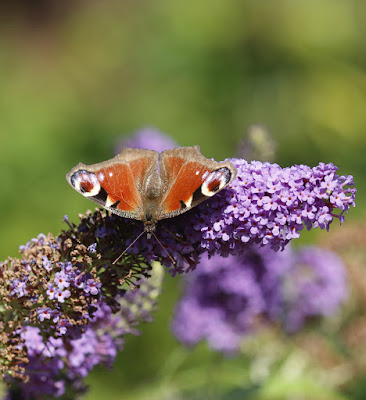I have declared the drive we share with our neighbour a Nature Reserve. It's all unofficial but with the willing agreement of our neighbour, no insecticide or herbicide will be let loose on any of the vegetation. What little weeding is required will be done by hand. Mine, I guess, but that is a price I'm willing to pay.
We already have five buddleias planted and flowering in the border alongside the bottom half of the drive and a very old, twenty foot high hedge which is a mixture of Holly, Elder and Ivy extends along the other half of the drive by the end of our house.
I plan to introduce various butterfly friendly plants such as Knapweed, Sedum, Scabious and vetches under and around the buddleias to extend the season and hopefully attract more species of butterflies and insect life. The Holly Hedge has, in the twenty plus years we have lived here, always harboured a colony of Holly Blues, although our previous neighbour was going to fell the hedge before I pleaded for it to be left intact. Thankfully I was successful in persuading them to leave it be.
Today there was a very strong but warm wind blowing, moving the countless leaves on the trees to create an endless flickering of sunlight and shadows across the ground, like ripples on a pond. The buddleias were again busy with butterfly life, the fragile insects being tossed and jostled by the wind as it blew the flower cones into a frenzy of movement. The gusts came regularly but the butterflies clung on with closed wings, riding the bucking flower cones until a lull ensued between each gust of wind.
A subtle change was apparent in the numbers and species of butterfly that were here today. Many more Small Tortoiseshells and Large White butterflies were now visiting the flowers. Last week there was only one Small Tortoiseshell but now up to nine or ten were making the most of the flowers. Each was looking fresh and presumably their condition and the increased numbers are the result of them recently hatching. In contrast the Large Whites were showing obvious signs of their perilous existence with battered and torn wings and it was only the occasional individual that looked untouched.
A subtle change was apparent in the numbers and species of butterfly that were here today. Many more Small Tortoiseshells and Large White butterflies were now visiting the flowers. Last week there was only one Small Tortoiseshell but now up to nine or ten were making the most of the flowers. Each was looking fresh and presumably their condition and the increased numbers are the result of them recently hatching. In contrast the Large Whites were showing obvious signs of their perilous existence with battered and torn wings and it was only the occasional individual that looked untouched.
 |
| Small Tortoiseshells |
The Peacock's closed wings are virtually featureless, almost an unsullied soot black, rendering them slightly sinister but when they partially open their wings the vivid contrast in colours could not be more stark and glorious, and so is it also for the Small Tortoiseshell, whilst the Red Admiral shows a much more varied, almost colourful underwing in comparison. Many of the butterflies were closing their wings for short periods this afternoon no doubt to aid some form of thermo-regulation in the warm sun but then would wander over the buddleia cones, partially opening and shutting their wings as if unsure which pose to adopt, open or closed.
 |
| Peacocks |
 |
| Red Admirals |
I can easily stand for an hour or more just watching the non stop activity of these wonderfully coloured and patterned insects and it is all here, literally feet from my doorstep.
Right outside the house is the holly hedge, just metres from our kitchen window. Here, in the afternoon come Common Starlings from the surrounding fields, many of them young birds slowly moulting into their iridescent adult black and white spotted plumage. They form a sociable gathering every afternoon to murmur, chuckle, gurgle and click away with countless vocalisations, high in the hedge, safe and secure in the ragged, uneven holly tops, holding what for all the world appears to be a conversation about the successes or otherwise of how the day has gone.
They are usually joined by our resident flock of House Sparrows who contribute to the murmurings with hard, loud chirrups. In winter this same evergreen hedge is a safe roosting place for Blackbirds, Song Thrushes and Redwings as well as the Common Starlings and House Sparrows. Goldcrests often pass through it in the winter months and at migration times it usually harbours the occasional Common ChiffChaff, Willow Warbler and Blackcap.
 |
| Juvenile Common Starling |
And as long as I am here so it will all remain.





















No comments:
Post a Comment